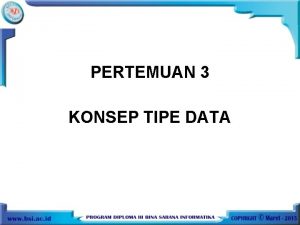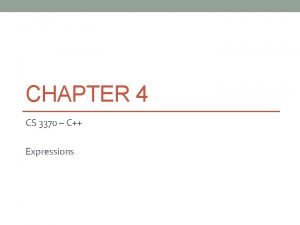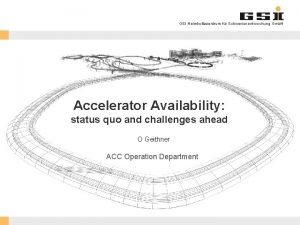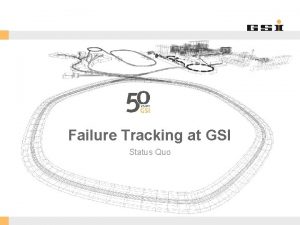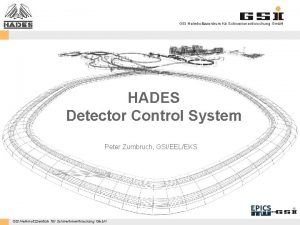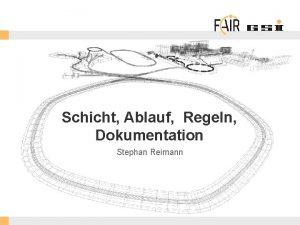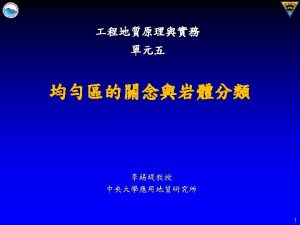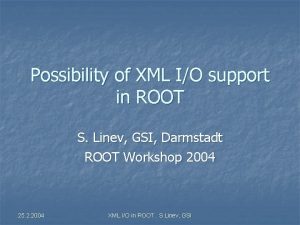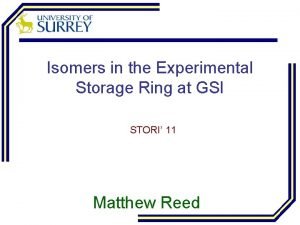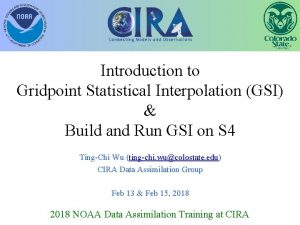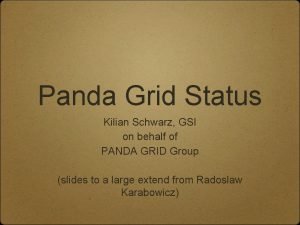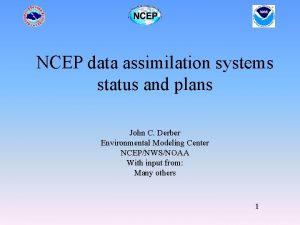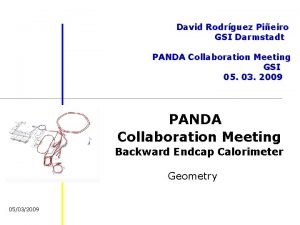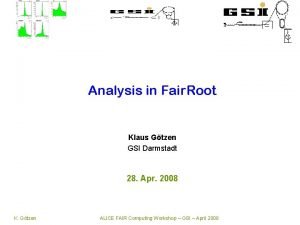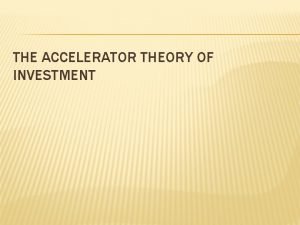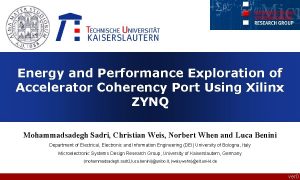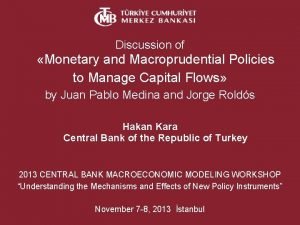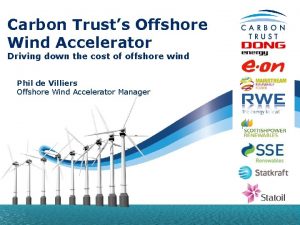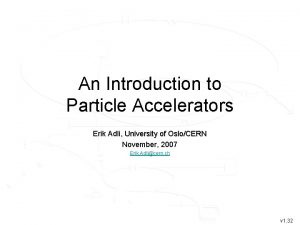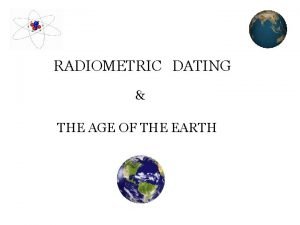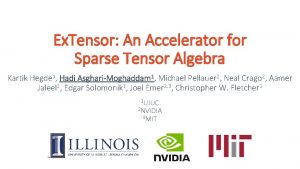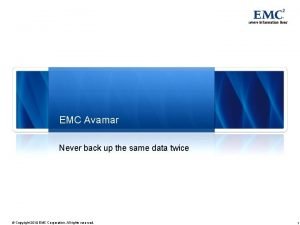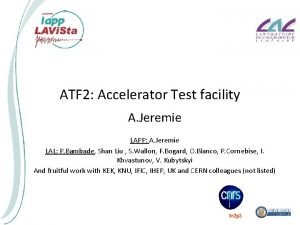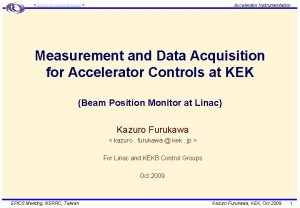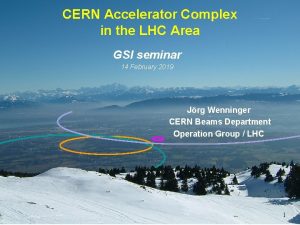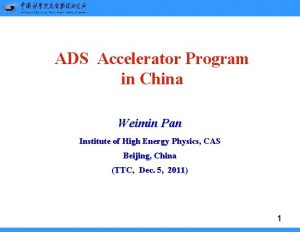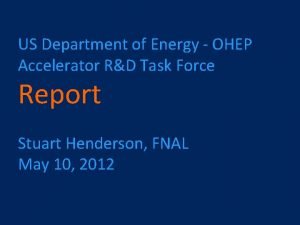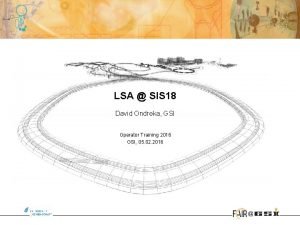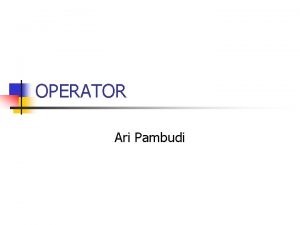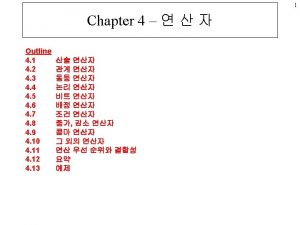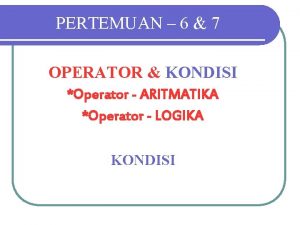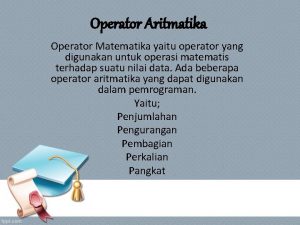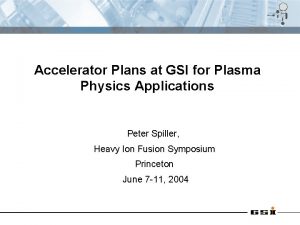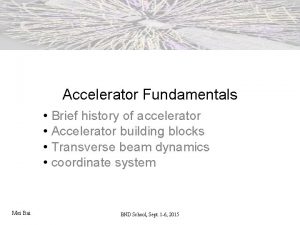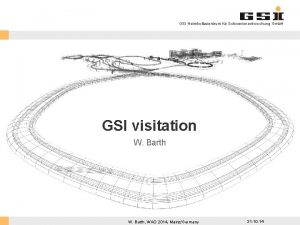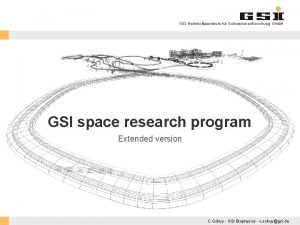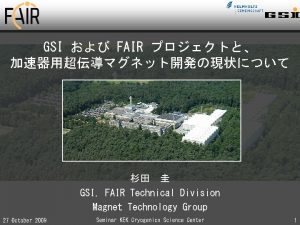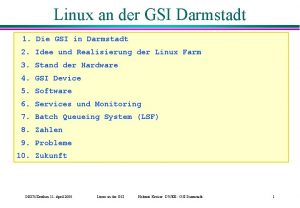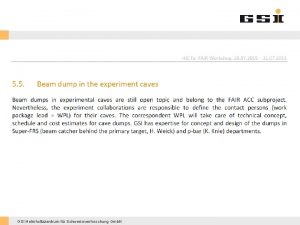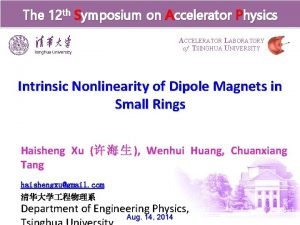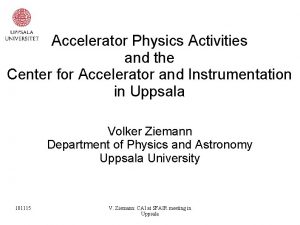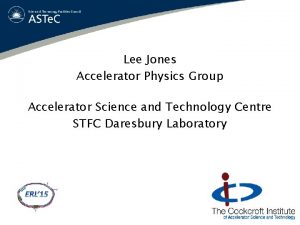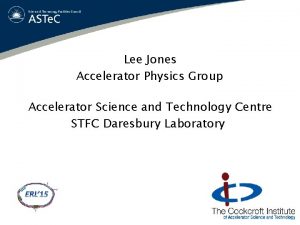Introduction to Accelerator Physics D Ondreka GSI Operator





















![• Bending Magnets @ GSI and FAIR Machine Type N θ [deg] ρ • Bending Magnets @ GSI and FAIR Machine Type N θ [deg] ρ](https://slidetodoc.com/presentation_image_h2/237f32f0ee61c7d35486b3febfe469a4/image-22.jpg)

























- Slides: 47

• Introduction to Accelerator Physics D. Ondreka, GSI Operator Training 2016

• Outline Introduction Particles and units Relativity Charged particles in fields Magnets Charged particle dynamics Emittance and acceptance 27. 01. 2016 Accelerator Physics / OP-Training 2016 2

• Experimenters wishes What are these fancy symbols here about: p, Au, N, Ni ? What do these funny numbers mean: 3. 6 Me. V/u, 300 -1000 Me. V/u, 1 e 8/spill ? What do our accelerators have to do with all this? 27. 01. 2016 Accelerator Physics / OP-Training 2016 3

• Elements and Isotopes Elements – atomic building blocks of matter – characterized by atomic number Z • number of protons in nucleus and electrons in neutral atom • one-to-one correspondence to chemical symbol X Isotopes – variants of the same element with different number N of neutrons – identified by mass number A = Z + N – same electron configuration, hence same chemical properties – only few isotopes stable Notation 27. 01. 2016 AX Z A N Abundance 40 Ca 20 40 20 96. 9% 48 Ca 20 48 28 0. 2% Accelerator Physics / OP-Training 2016 neutron-rich nucleus, often used for SHE experiments 4

• Elements (Source: http: //www. pctheory. uni-ulm. de/didactics/quantenchemie/html/PSE-F. html) Ordering of elements according to atomic number Z and electron configuration 27. 01. 2016 Accelerator Physics / OP-Training 2016 5

• Isotopes Source: http: //moriond. in 2 p 3. fr/radio/moriond-huyse. ppt Ordering of elements according to proton number Z and neutron number N 27. 01. 2016 Accelerator Physics / OP-Training 2016 6

• Ions Acceleration requires charged particles (we’ll come to that. . . ) Ions – created by removing electrons from atoms (or molecules) – characterized by their charge state Q – notation for ions of atoms (i. e. isotopes) A XQ Z Q #electrons 48 Ca 20 0 20 48 Ca 10+ 20 10 10 – notation for molecules similar • examples: H 2+, H 3+, CH 3+ – creation of ions from neutral particles in ion sources – increasing of charge state by stripping in gas or foils 27. 01. 2016 Accelerator Physics / OP-Training 2016 7

• Ion Masses Acceleration of ions depends on mass of ion – Need to know the masses of ions SI units impractical: – mp ≈ mn ≈ 1. 7· 10 -27 kg Atomic mass units (AMU) – definition of atomic mass unit: m(12 C) = 12 u = A·u SI units AMU ME u 1. 661· 10 -27 kg 1 u 0 mp 1. 672· 10 -27 kg 1. 007 u 0. 007 mn 1. 675· 10 -27 kg 1. 009 u 0. 009 m(12 C) 1. 993· 10 -26 kg 12 u 0 m(48 Ca) 7. 965· 10 -26 kg 47. 953 u -0. 047 me 9. 109· 10 -31 kg 5. 5· 10 -4 u n. d. – for general isotopes we define a mass number M: m(AX) = M·u ≈ A·u – small difference between A and M: • mass excess ME: M = A + ME ME/M < 0, 1% (except e. g. p, d) • missing electrons for ions: m(AXQ) = (M - Q·Ae)·u but this is the origin of nuclear power. . . Z·Ae /M < 0, 05% • significant for high precision exp. (e. g. mass measurements in storage rings) 27. 01. 2016 Accelerator Physics / OP-Training 2016 8

• Ion Energies Experimentalists require ions with a certain kinetic energy – usually specified as kinetic energy per atomic mass unit – example: 238 U 73+, E=1 Ge. V/u, Nions=109 particles – what’s this mysterious ‘Ge. V’? • elementary charge: e = 1. 602· 10 -19 C charge of proton and electron (up to sign) • when pushed by a voltage of 1 V, a particle with charge e gains energy 1 e. V • in SI units: 1 e. V = 1. 602· 10 -19 J • prefixes for saving digits: 1000 e. V=1 ke. V, 1000 ke. V=1 Me. V, 1000 Me. V=1 Ge. V – what’s the kinetic energy of the beam in the example? • A = 238, ME = 0. 05 u, Q = 73 M = 238. 01, m = M·u • Eion = M·u·E = 238. 01 Ge. V • Ebeam = Nions· Eion = 109· 238. 01 Ge. V = 238. 01· 1018 e. V ≈ 40 J – kinetic energy of a walking man: E = 1/2·m·v 2 = 1/2· 80 kg· 1(m/s)2 = 40 J – if deposited in 1 ml of water: heating by 10 degrees, dose 40000 Gy 27. 01. 2016 Accelerator Physics / OP-Training 2016 9

• Relativity: Mass and Energy Mass and energy are equivalent E = mc 2 What’s the energy of a mass unit? – speed of light (constant of nature): c = 299792458 m/s – energy of 1 u: • u·c 2 ≈ 1. 661· 10 -27 kg·(2. 998· 108 m/s)2 ≈ 1. 4925· 10 -8 J • 1 e. V ≈ 1. 602· 10 -19 J • u·c 2 ≈ 931. 6· 106 e. V • precise value: u·c 2 = 931. 494 Me. V Expression of masses as energies in convenient units – consider 238 U 73+: m·c 2 = M·u·c 2 = 238. 01·u·c 2 = 221. 7 Ge. V – also written as: m = 221. 7 Ge. V/c 2 27. 01. 2016 Accelerator Physics / OP-Training 2016 10

• Relativity: Energy equivalent to mass is referred to as rest energy 2 2 – will use symbol E 0 from now on: E 0 = mc = M·uc – use special symbol Eu for amu: Eu = uc 2 Kinetic energy of ion always proportional to mass – write kinetic energy as: Eion = M·E – E is referred to as kinetic energy per nucleon (or per atomic mass unit) Total energy is the sum of rest and kinetic energy – again proportional to mass: M·Etot = M·(E + Eu) Comparison of total energy to rest energy – defines the relativistic gamma: γ = Etot/Eu = 1 + E/Eu – examples: • injection into SIS 18: E = 11. 4 Me. V/u γ = 1 + 11. 4/931. 5 = 1. 01 • extraction from SIS 18: E = 1 Ge. V/u γ = 1 + 1000/931. 5 = 2. 07 27. 01. 2016 Accelerator Physics / OP-Training 2016 11

• Relativity: Velocity expressed in units of the speed of light – defines relativistic beta: v = β·c Gamma and beta are related γ = 1/√(1 - β 2) – Lorentz factor: – can be inverted: β = √(1 - 1/γ 2) Velocity bound by speed of light – Look again at γ = 1 + E/Eu • E=0 γ = 1 β = 0 • E ->∞ γ ->∞ β -> 1 • range of beta: 0≤β<1 – Ions never reach the speed of light • but they can come quite close: (e. g. p@LHC: E=7 Te. V, γ≈7500, 1 -β≈10 -8) 27. 01. 2016 Accelerator Physics / OP-Training 2016 12

• Relativity: Momentum is an important kinematical quantity – conserved if no forces act on the particle – deflection in a magnet is proportional to momentum (we’ll come to that. . . ) Related to the other relativistic parameters – proportional to mass: pion = M·p – non-linear relation to velocity: pc = γ·β·Eu = β/√(1 - β 2)·Eu – non-linear relation to energy: pc = √(E·(E + 2·Eu)) – example: E = 1 Ge. V pc = 1692 Ge. V or p = 1692 Ge. V/c 27. 01. 2016 Accelerator Physics / OP-Training 2016 here we’ve omitted the /u for convenience. . . 13

• Relativity: Non-Relativistic Limit Newton’s physics recovered for small energies – Newton’s relations for momentum: p = u·v p = √(2·u·E) – check of velocity relation: • let β -> 0 pc = β/√(1 - β 2)·Eu -> β·Eu = c·u·βc = c·u·v – check of energy relation: • let E -> 0 pc = √(E·(E + 2·Eu)) ->√(2·Eu·E) = c√(2·u·E) How far does Newton’s arm reach? – depends on required precision • consider relation between momentum and velocity • define deviation from Newton’s relation by: β/(βγ) = 1 - ε with 0 < ε < 1 • below this β, deviation from linearity smaller than ε 27. 01. 2016 Accelerator Physics / OP-Training 2016 ε γ β E 0. 1 1. 11111 0. 436 103 Me. V/u 0. 01 1. 01010 0. 141 9. 4 Me. V/u 0. 001 1. 00100 0. 045 932 ke. V/u 0. 0001 1. 00010 0. 014 93. 2 ke. V/u 0. 00001 1. 00001 0. 004 9. 32 ke. V/u last line still corresponds to 1300 km/s = 1. 3 m/μs! 14

• How Relativistic are GSI and FAIR? CRYRING UNILAC (β < 0. 15) and CRYRING (β < 0. 25) close to non-relativistic SIS 18 and SIS 100 practically always relativistic SIS 100 for protons at extraction pretty relativistic (γ ≈ 30) For comparison: LHC @ 7 Te. V γ ≈ 7500 (now this is ultra-relativistic. . . ) 27. 01. 2016 Accelerator Physics / OP-Training 2016 15

• Lorentz Force and Magnetic Rigidity Lorentz force on charged particles in electromagnetic fields F = Q·e ( E + v x B) = M·dp/dt – general equation involving 3 D vector quantities (F, E, v, B, p) – electric field E will accelerate particle if aligned with v – force by magnetic field B always perpendicular to v -> no acceleration – change of momentum per nucleon proportional to Q/M Particle in homogenous magnetic field B – energy remains constant – trajectory is circle with radius ρ satisfying: B·ρ = M/Q·p – fundamental relation for accelerator physics – quantity Bρ denoted magnetic rigidity – the larger Bρ, the harder it is to deflect the particle by a magnetic field – for fixed p rigidity determined by mass-to-charge ratio M/Q 27. 01. 2016 Accelerator Physics / OP-Training 2016 16

• Manetic Rigidity: Examples Ions SIS 18 Inj. SIS 18 Ext. SIS 100 Ext. E=11. 4 Me. V/u E=1 Ge. V/u E=1. 5 Ge. V/u Ion M/Q Bρ [Tm] 40 Ar 18+ 2. 22 1. 08 12. 5 16. 6 40 Ar 10+ 4. 00 1. 95 n. a. 30. 0 86 Kr 33+ 2. 61 1. 27 14. 7 19. 5 86 Kr 16+ 5. 38 2. 62 n. a. 40. 3 238 U 73+ 3. 26 1. 59 18. 4 24. 4 238 U 28+ 8. 50 4. 14 n. a. 63. 7 Protons SIS 18 Inj. (UNILAC) SIS 18 Inj. (p-Linac) SIS 18 Ext. SIS 100 Ext. E=11. 4 Me. V/u E=70. 0 Me. V/u E=4 Ge. V/u E=29 Ge. V/u M/Q Bρ [Tm] 1. 007 0. 49 1. 26 16. 3 100 27. 01. 2016 Accelerator Physics / OP-Training 2016 17

• Deflection in Dipoles Dipole with a uniform field deflects a charged particle by an angle θ θ depends on arc length L and magnetic field B L L depends on θ and radius ρ L = θ·ρ ρ Particle with magnetic rigidity Bρ θ B·L = θ·Bρ Quantity B·L is referred to as integral magnetic field Deflection angle given by θ = B·L/Bρ 27. 01. 2016 Macroscopic angles to bend transfer lines or create circular accelerators bending magnets Microscopic angles to correct beam trajectory or closed orbit steering magnets Accelerator Physics / OP-Training 2016 18

• Dipoles as Separators Consider particles with fixed p but different M and Q in a dipole field B – assume B·L same for all M, Q – deflection angle given by θ = Q/M · B·L/p Charge separation – assume same M, but different Q – let only one angle θ pass and vary B, then Q proportional to 1/B Some separator magnets are rather large. . . Mass separation – assume same Q, but different M – let only one angle θ pass and vary B, then M proportional to B. . . and one can build separators with more dipoles. 27. 01. 2016 Accelerator Physics / OP-Training 2016 19

• Example: Spectrometer Charge separation behind gas stripper Mass (isotope) separation 27. 01. 2016 Accelerator Physics / OP-Training 2016 20

• Dipole Magnets Homogeneous field desired At GSI and FAIR electromagnets with and iron core are used B field created in gap g between two parallel iron poles N and S N B g C core dipole S e. g. ESR, CRYRING B field excited by current in coil with N windings N B field can be calculated H core dipole B = μ 0·N·I/g μ 0 = 4π· 10 -7 Tm/A (constant of nature) S e. g. SIS 18, SIS 100 Choice of coils – Normal conducting (water cooled) N Window frame dipole • e. g. SIS 18, ESR, FRS – Super-conducting (liquid He cooled) S • e. g. SIS 100, Super-FRS 27. 01. 2016 Accelerator Physics / OP-Training 2016 21
![Bending Magnets GSI and FAIR Machine Type N θ deg ρ • Bending Magnets @ GSI and FAIR Machine Type N θ [deg] ρ](https://slidetodoc.com/presentation_image_h2/237f32f0ee61c7d35486b3febfe469a4/image-22.jpg)
• Bending Magnets @ GSI and FAIR Machine Type N θ [deg] ρ [m] L [m] Bmax [T] BLmax [Tm] Bρmax [Tm] SIS 18 H 24 15 10. 4 2. 7 1. 8 4. 9 18. 7 ESR C 6 60 6. 25 6. 5 1. 6 10. 5 10. 0 CRYRING C 12 30 1. 20 0. 63 1. 2 0. 75 1. 44 SIS 100 H 108 3. 33 52. 6 3. 1 1. 9 5. 8 100. 0 CR H 24 15 8. 13 2. 1 1. 6 3. 4 13. 0 HESR H 44 8. 18 29. 4 4. 2 1. 7 7. 1 50. 0 And a large variety of bending magnets in the transfer lines and at the experiments. . . 27. 01. 2016 Accelerator Physics / OP-Training 2016 22

• Particle Motion in Dipole Magnets Can we build circular accelerators from dipoles only? Start two particles in same field – same momentum, same position – different angle Use particle A’s trajectory as reference and measure deviation of B’s trajectory along the circle – particle B oscillates around particle A – such oscillations characterize transverse motion in accelerators – more about that later. . . (see talk on ‘Transverse Dynamics’) deviation – referred to as betatron oscillations Particle B Particle A 2π 0 27. 01. 2016 Accelerator Physics / OP-Training 2016 23

• Stable or Unstable Motion In the previous example, horizontal trajectories close on themselves – motion considered to be stable – focusing effect of the dipole field What about the vertical motion? horizontal dev. – could be repeated infinitely Horizontal relative motion 0 2π 4π – particle A at zero position and angle – particle B with same position but small angle at start – position of particle B grows without bounds over many turns – motion considered to be unstable vertical dev. – the dipole field has no influence on the vertical motion of both particles Vertical relative motion 0 2π 4π Need focusing in the vertical direction 27. 01. 2016 Accelerator Physics / OP-Training 2016 24

• Quadrupole Magnets Magnetic field Quadrupole magnet has 4 poles symmetric about the center By symmetry the B field on the longitudinal axis is zero – particle passes straight through the center with no deflection – quadrupole magnet is straight B field depends linearly on position – horizontal direction: By = B’·x – vertical direction: Bx = -B’·y – B’ referred to as field gradient Hyperbolic contour x · y = constant Integral quadrupole strength k·L = B’·L/Bρ – focusing power for particles with Bρ – analogous to angle of a dipole 27. 01. 2016 Accelerator Physics / OP-Training 2016 25

• Effect of Quadrupole Magnets Focusing quadrupole (QF) Forces on particles determined by arrangement of poles – arrangement Force on particles NS SN • focusing in horizontal plane • defocusing in vertical plane • denoted focusing quadrupole (QF) – arrangement SN NS • defocusing in horizontal plane x • focusing in vertical plane • denoted defocusing quadrupole (QD) QF s Forces linear in transverse position – particles receive deflection proportional to their position y – similar to lenses in optics except that lenses (de)focus in both planes 27. 01. 2016 Accelerator Physics / OP-Training 2016 QF s 26

• Focusing with Quadrupole Magnets Neither QF nor QD can focus in both x and y simultaneously, but. . . Combinations of QF and QD with overall focusing in x and y possible Idea: x QD QF QD y QD QF QD – put QD in place where horizontal offsets are small – put QF in place where vertical offsets are small – then effect of QD on x respectively QF on y should be small Different arrangements possible FODO Doublet – FODO: smallest field gradients – Doublet: long free section Triplet – Triplet: symmetric beams 27. 01. 2016 Accelerator Physics / OP-Training 2016 27

• Transverse Phase Space Consider again focusing by QF in the horizontal plane x focal point QF – parallel input trajectories particles characterized by position x s – at focal point, all particles have x = 0 particles characterized by angle x’ In general, position x and angle x’ needed to fully describe particle – aggregated into vector x’ – can be depicted in 2 D coordinate system called phase space – convergent trajectories have negative x’ for positive x and vice versa x – opposite sign for divergent trajectories Vertical plane completely analoguos 27. 01. 2016 Accelerator Physics / OP-Training 2016 28

• Quadrupole Effect Quantitatively Consider thin quadrupole at s = 0 Input vector (just in front of quad) x Output vector (just behind quad) s – same position x 1 (thin quad) – angle of trajectory: -x 1/f (x 1<< f) f Vector downstream of quad at s – angle fixed in drift space – position change linear in s 27. 01. 2016 Accelerator Physics / OP-Training 2016 29

• Matrix Formalism Matrices and vectors Multiplication rules for matrices and vectors – mathematical structures with a very powerful calculus (linear algebra) Matrix · Vector = Vector – easily implemented in computer programs – very convenient for representing particle transport through accelerators with linear forces Matrix · Matrix = Matrix – takes some time getting used to it. . . Multiplication not commutative. . . but associative 27. 01. 2016 Accelerator Physics / OP-Training 2016 30

• Quadrupoles and Drifts as Matrices Effect of thin quadrupole with focal length f described by matrix x’ x – first row: position x is unchanged and does not depend on angle x’ – second row: quad changes angle x’ by amount proportional to position x Effect of drift space of length L x’ – first row: position x changes by amount proportional to angle x’ x – second row: angle unchanged Can be visualized in phase space 27. 01. 2016 Accelerator Physics / OP-Training 2016 31

• FODO Focusing Alternating focusing and defocusing quadrupoles separated by drift spaces FODO cell can be repeated many times (periodic FODO channel) Dipole magnets installed between quadrupoles for curved accelerators QD QF L FODO cell Matrix formalism allows to split quads easily. . . – approximately like drift spaces Efficient focusing structure regarding necessary fields for given aperture Matrix of FODO cell Periodic solution exists – output beam same as input beam Just for the curious and brave. . . – ellipses in phase space – other beam shapes may lead to troubles (mismatch) 27. 01. 2016 Accelerator Physics / OP-Training 2016 32

• FODO Tracking: Trajectories QF QD L QF L Trajectories in horizontal plane Trajectories in vertical plane Tracks obtained by tracking 20 particles Particle tracks obtained by tracking random sample of particles General properties of FODO structure visible, but where are the limits? 27. 01. 2016 Accelerator Physics / OP-Training 2016 33

• FODO Tracking: Envelopes QF QD L QF L Envelopes in horizontal plane Envelopes in vertical plane Tracks obtained by tracking 2000 particles Shape of beam emerges when tracking lots of particles Envelope can actually be calculated from L and f ( talk on transverse optics) 27. 01. 2016 Accelerator Physics / OP-Training 2016 34

• FODO Focusing: Mechanical Analogue Ball rolling without friction in a gutter can’t escape due to force of gravity 27. 01. 2016 Particles diverging from nominal orbit focused back by quadrupoles Accelerator Physics / OP-Training 2016 35

• FODO Tracking: Cross section QF QD L QF L Beam cross sections in x-y Cross sections reflect the change of beam size through FODO cell In real accelerator observable using scintillating screens – not possible for beam in a circular accelerator – typically not inside of quadrupoles, of course. . . 27. 01. 2016 Accelerator Physics / OP-Training 2016 36

• FODO Tracking: Phase Space QF QD L QF L Horizontal phase space Vertical phase space Important property of beam, but not directly observable in a real accelerator – how would you measure the angle of a trajectory simultaneously with position? 27. 01. 2016 Accelerator Physics / OP-Training 2016 37

• FODO Tracking: Beam Profiles QF QD L QF L Horizontal beam profiles Vertical beam profiles Projections of phase space onto position can be observed – beam profiles measured by SEM-grids, MWPCs, BIFs, IPMs – very important information for set-up of accelerators and beamlines 27. 01. 2016 Accelerator Physics / OP-Training 2016 38

• FODO Tracking: Mismatch QF QD L QF L Horizontal phase space Vertical phase space Important property of beam, but not directly observable in a real accelerator – how would you measure the angle of a trajectory simultaneously with position? 27. 01. 2016 Accelerator Physics / OP-Training 2016 39

• Emittance Oscillation amplitude of single particles normally conserved – remember the frictionless gutter: ball will oscillate forever – measure of transverse energy Transverse energy referred to as single particle emittance – transverse energy created by random motion in the source – conserved (at best) until final target – measure of disorder of particles in the beam – impossible to create truly parallel beam (would be completely ordered) 27. 01. 2016 Accelerator Physics / OP-Training 2016 40

• Beam Size and Emittance Periodic solution of FODO cell characterized by ellipses – aspect ratio defined by quadrupoles – for upright ellipses, aspect ratio described by beta functions βx/y – area of ellipse written as – emittance εx/y measure for beam size Emittance is constant in FODO cell – small width implies large angle spread – limits the beam spot size at a target – impossible to create parallel beam Skew ellipses talk on Transverse Optics 27. 01. 2016 Accelerator Physics / OP-Training 2016 41

• Emittance Change Sources of emittance growth – scattering in stripping foil or targets – ellipse mismatch – non-linear fields Ways to shrink emittance – acceleration shrinks emittance according to ε ~ 1/p ~ 1/Bρ (adiabatic damping) – electron cooling (SIS, ESR) and stochastic cooling (ESR) available to create very small emittances Unnecessary emittance growth can limit performance – beam losses due to beam size growth – larger beam spot size at targets 27. 01. 2016 Accelerator Physics / OP-Training 2016 42

• Emittance and Acceptance Emittance: area of phase space ellipse containing a fraction of particles (e. g. 95%) – may grow due to mismatch, non-linear fields, beam interaction with pipe, etc. – does not take into account deviations of beam center from ideal orbit Acceptance: maximum area of the ellipse possible without ever losing particles (by hitting beam pipe) – acceptance in general smaller than physical aperture of beam pipe – need some margin for deviations of beam center and emittance growth 27. 01. 2016 Accelerator Physics / OP-Training 2016 43

• Non-Linear Magnets: Sextupoles N Magnet with six poles Field depends quadratic on position – forces on particles non-linear – in general no analytic solutions S S N N By ~ x 2 for y=0 S – can even lead to chaotic motion Particle motion during slow extraction (SIS 18) Frequently used in accelerators – correction of momentum dependent effects on betatron oscillations (e. g. SIS 18, ESR, FRS) – essential for slow extraction (SIS 18) – compensation of unavoidable field errors in magnets (dipoles) 27. 01. 2016 Accelerator Physics / OP-Training 2016 44

• Non-Linear Magnets: Octupoles for SHIP beamline – deformation of ellipse by non-linear field of octupoles – uniform distribution in cross section – higher beam intensity at equal maximum particle density on target 27. 01. 2016 Accelerator Physics / OP-Training 2016 45

• Summary Definition of elements and isotopes Special relativity and electro-dynamics – masses, energies and mass-energy relation – Relativistic particle motion and non-relativistic limit – Lorentz force and magnetic rigidity Motion of charged particles in magnetic fields – dipoles as bending magnets and separators – quadrupoles as focusing magnets – non-linear magnets for more sophisticated purposes Particle tracking and transverse phase space – vectors for description of particles and matrix formalism – FODO focusing structure – emittance and acceptance 27. 01. 2016 Accelerator Physics / OP-Training 2016 46

Thank you for your attention! These slides contain material I found in talks of the following colleagues: W. Bayer and M. Maier (GSI), R. Steerenberg (CERN), K. Peach (Oxford University) I’m very grateful for the possibility of profiting from their excellent material. 27. 01. 2016 Accelerator Physics / OP-Training 2016 47
 Pada tipe data boolean berlaku operator-operator adalah
Pada tipe data boolean berlaku operator-operator adalah Pada tipe data boolean, berlaku operator-operator :
Pada tipe data boolean, berlaku operator-operator : Logical operators priority in c
Logical operators priority in c Unary binary operator
Unary binary operator Pixel gsi
Pixel gsi Gsi calendrier académique
Gsi calendrier académique Gsi
Gsi Olog gsi
Olog gsi Gsi
Gsi Dokumentation schichtübergabe
Dokumentation schichtübergabe Gsi hoek
Gsi hoek Gsi parser
Gsi parser Gsi calendrier académique
Gsi calendrier académique Gsi
Gsi Gsi
Gsi Hs iv
Hs iv Kilian schwarz
Kilian schwarz Ncep model status
Ncep model status Gsi panda
Gsi panda Gsi root
Gsi root Transformational leadership questionnaire
Transformational leadership questionnaire Accelerator theory of investment
Accelerator theory of investment Biztalk swift
Biztalk swift Netbackup track log location
Netbackup track log location Fiscal policy definition
Fiscal policy definition Accelerator coherency port
Accelerator coherency port Financial accelerator
Financial accelerator Offshore wind accelerator
Offshore wind accelerator Erik adli
Erik adli Vmware backup best practices
Vmware backup best practices Accelerator mass spectrometry
Accelerator mass spectrometry Coherent accelerator processor interface
Coherent accelerator processor interface Extensor: an accelerator for sparse tensor algebra
Extensor: an accelerator for sparse tensor algebra Avamar ndmp accelerator
Avamar ndmp accelerator Charter network accelerator
Charter network accelerator Accelerator
Accelerator Accelerator
Accelerator Microsoft virtual machine converter download
Microsoft virtual machine converter download United way social innovation accelerator
United way social innovation accelerator Ccat azure accelerator
Ccat azure accelerator Cern accelerator complex
Cern accelerator complex Growth accelerator coach
Growth accelerator coach Ads accelerator
Ads accelerator Medical particle accelerator
Medical particle accelerator Salesforce cpq accelerator
Salesforce cpq accelerator Sandra biedron
Sandra biedron Talent accelerator program
Talent accelerator program Stanford linear accelerator tours
Stanford linear accelerator tours
